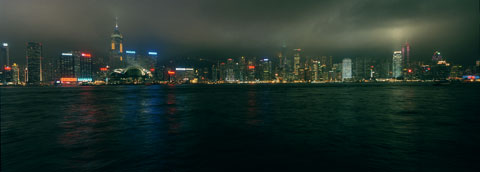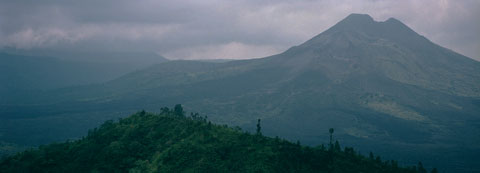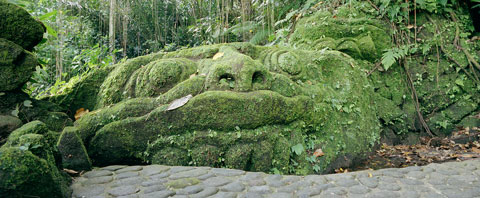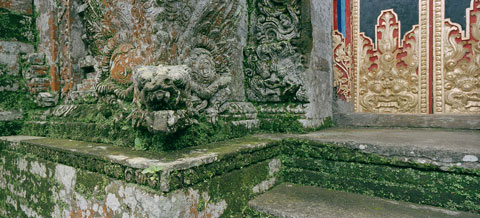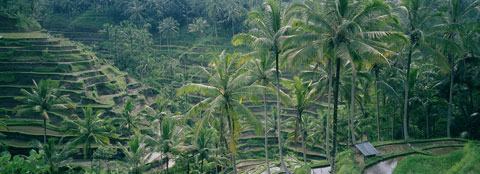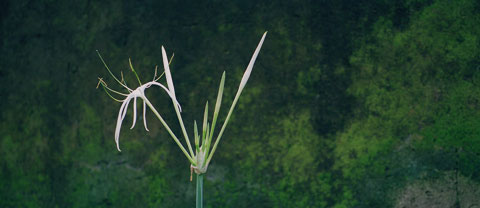In late February, 2000 my wife and I took a vacation inBali, Indonesia, with stop-offs inHong KongandSingapore. Though not a photographic trip per se I took along myHasselblad XPancamera system and in particular the new30mm ultra-wide angle lens, which had arrived just days before departure. I believe that I am the first person outside of Japan to have obtained one of these lenses, and I have written thefirst reviewof it to appear anywhere in print. This portfolio features selected images from that trip and is likely also the first public exhibit of photographs taken with this new 30mm ultra-wide.
Also, because my impressions of Bali are so strong, I’ve added more commentary about the locale than I normally would in a photo essay. This wasn’t a photographic trip, rather a vacation with my wife, so I didn’t use a full sized tripod and only did photography en-passant as part of our explorations. Therefore, this section shouldn’t be regarded as one of my typical portfolios. I hope you enjoy it.
Hong Kong First
Hong Kong is the most convenient gateway to the rest of Asia and I have visited there frequently on business, but never on a vacation. All four of our days there were cool and rainy, which restricted my ability to do much photography, but provided an unneeded excuse to go shopping. (Eating and shopping in Hong Kong are one of life’s great experiences).
On the first day, after an afternoon nap to help recover from jet lag, I was eager to try out the new 30mm lens. As night fell I walked in the rain along the promenade on theKowloonside ofVictoria Harbour, and using a small table-top tripod on the edge of the sea-wall took this 8 second exposure @ f/16. My first exposure of the trip. The rain and mist helped add some character to the sky but muted the reflections in the water.
The reason for the awkward framing of this shot, with the horizon line through the middle of the frame, is that if I’d tilted the camera upward from dead-level the horizon would exhibit barrel distortion due to its extreme wide angle of coverage. Not a fault of the lens, just a function of the angle of view. Now if Hasselblad and Fuji would just make a model of the XPan with a rising front 🙂
Photographed with a Hasselblad XPan and 30mm f/5.6 lens on Kodak VC400 film.
Bali
The island ofBali,part of theIndonesianarchipelago, was our primary destination. Fortunately it sharesnoneof that country’s unfortunate and seemingly endemic racial intolerance and violence. I found Bali to be one of the most exotic places in the world that I’ve ever visited. It is an island of artists, temples and rare natural beauty. Bali’s people are primarily Hindus, and religion permeates every aspect of their lives. Each family compound contains a temple as does every village and town. The gods inhabit the landscape‚ from the rice fields to the holy mountains and rivers.
Because February is still the rainy season in Bali we spent much of the time touring the island with conditions of heavy to broken overcast. During a break in the weather one morning we stopped for a cold drink at a road-side café near the town ofPenelokan. The view from our cliff-side table was magnificent andMt. Batur, a recently active volcano, peaked through the clouds for a while.
Photographed with a Hasselblad XPan and 90mm lens on Kodak VC400 film.
At the bottom of a long steep jungle trail leading down to the sacredAyung Riverin centralBali,I came across a small alter with a religious ceremony underway. Not wanting to disturb the worshipers I continued down the trail a few yards and came across this apparently ancient idol’s head carved into a large rock beside the footpath. The jungle canopy was very heavy but a small tabletop tripod placed on the ground allowed for an exposure of 8 seconds @ f/11‚ the XPan’s longest autoexposure speed.
Photographed with a Hasselblad XPan and 30mm f/5.6 lens on Kodak VC400 film. (This image is cropped slightly from its full width).
Temples pervade Balinese life. They are everywhere. Some are relatively new or refurbished, but many are hundreds of years old. I fell in love with photographing the temple architecture, and found the XPan 30mm lens ideal for capturing the gargoyles as well as their context‚ such as these gilded temple doors.
This particular temple is calledKura Kehenand is located near the town ofBangli.
Photographed with a Hasselblad XPan and 30mm f/5.6 lens on Kodak VC400 film. (This image is cropped slightly from its full width).
Even the mountainous interior of Bali is heavily cultivated. Here, near the town ofSebatuis an example of the beautiful yet difficult to harvest rice terraces found on the island.
Photographed with a Hasselblad XPan and 30mm f/5.6 lens on Kodak VC400 film.
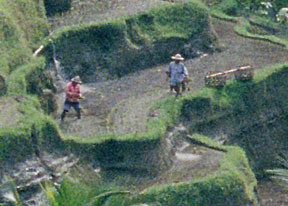 Rice Farmers, blow-up
Rice Farmers, blow-up
Worth noting for anyone reading this who has a particular interest in the new 30mm lens which I was testing, this frame is an enlargement of a section of the above picture. It is located center-left on one of the middle terraces. I only saw it when I wasspottingthe image inPhotoShopat "actual pixel" resolution. At this magnification the image would be7 feet wide!An impressive showing for both the 30mm Hasselblad XPan lens as well as Kodak’s new 400VC film.
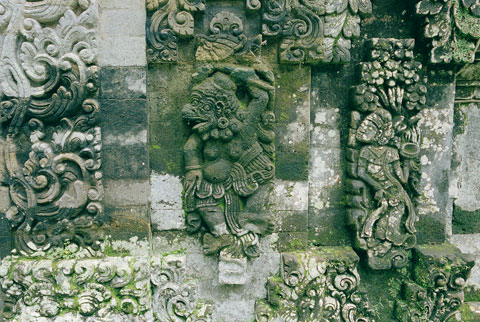 Temple Carving Detail, Bali‚ 2000
Temple Carving Detail, Bali‚ 2000
I was totally taken with the temples. The carvings and stonework ranged from ancient to recent, and as in the example above, sometimes both in the same small area.
One day I would love to return to Bali with a large format camera and to document the temples’ architectural details and carvings.
Photographed with a Hasselblad XPan and 30mm f/5.6 lens on Kodak VC400 film in standard 35mm mode.
The Island & Its Cultural
It would be presumptuous after only five days as a tourist to present anything other than broad-stoke observations about such an old, complex and exotic culture. Nevertheless, Bali made such a strong impression on me that some comments are called for.
The People
The Balinese are without doubt the gentlest most friendly people I have met. Almost everyone we met was courteous, warm and gracious. Admittedly as tourist we saw only one aspect of the culture, but I’ve traveled enough over the years to recognize the genuine thing. In Bali we found it.
Families live together in compounds. Grandparents, brothers, sisters and their children live together in a group of buildings surrounded by a walled enclosure. Each family compound has its own temple which forms the heart of the family community.
The Dogs & Chickens
They’re everywhere. Each family compound has a dog, a local mongrel breed called for some reason, peanut dogs. These are family pets, but we were told that their main purpose is to guard the family compound. They are noticeable because every family has one and they wander freely over the roadways. As do the chickens. Driving in Bali is therefore an ever-fascinating game ofchicken. Our driver/guide would always joke, "almost chicken soup that time", as he’d swerve to avoid another roadside hazard.
The Land
Bali is a relatively small island with a population of some 3 million people. It is crowded and even the rural highlands are intensively cultivated, mostly with rice terraces, but also with coffee, ginger, tapioca and a number of other crops which only grow in tropical highlands.
The main city ofDenpasarand the coastal region surrounding it are crassly commercial and best avoided. No worse than most of the Hawaiian islands, but regrettably, no better. Once you head inland though the complexion changes. Though some 60% of Bali’s economy is now based on tourism, once away from the coast it’s bearable, and of course allows for infrastructure such as some great resort hotels. We stayed at theAmandari, arguably one of the world’s finest small resorts, near the main artistic community ofUbud. If your travels ever take you to Bali I can recommend it without hesitation. Ask for villa #15. It faces both the rice terraces on one side and theAyungriver gorge on the other. A tropical paradise.
Photographed with a Hasselblad XPan and 90mm lens on Kodak VC400 film.
Religion & Temples
The Balinese practice a version of animist Hinduism. Gods pervade their lives and religion isn’t just practiced‚ it’s lived. Virtually every act, from opening a store in the morning to planting a rice crop entails making an offering to the appropriate god.
Art
This is a nation of artists and artisans. Almost every village has its specialty. In some it’s stone carving, in others painting or silversmithing. Each village has more store-fronts devoted to selling art than to any other activity. Importantly, this devotion to art is not solely a manifestation of tourism. These people were artists long before the second half of the 20th century and the influx of tourists caused by jet travel. Art, like religion, dance and music pervade Balinese life in a way unlike that of any culture that I am familiar with.
Learning More
There are many interesting and informative sites on the Web with additional information about Bali. One that I found useful is locatedhere.
Technical Notes
Film
I shoot colour transparency film almost exclusively. I find it easier to review shot material, and scanning reversal film is more straightforward than colour negatives. On this trip though I took only ISO 400 negative film, in this instanceKodak’snew400VC.
The reason for this is that I knew I’d be shooting mostly with the 30mm lens and it has an effective aperture, with the centre filter, of f/11. Also, I anticipated that if the weather was overcast (which it was almost every day), and jungle conditions were encountered (which they also were), I would need as fast a film as possible.
A couple of months before the tripI had testeda number if ISO 400 colour transparency film alternatives and found none of the solutions attractive. I chooseKodak 400VCbecause it promised saturated colour along with fine grain. I found that it delivered both, though if I had been able to use a proper tripod I would have stuck withProvia 100Ftransparency film.
Cameras & Tripods
Because this was a vacation and not a "shoot", I traveled as light as possible. This included bringing theHasselblad XPansystem in preference to any of my other cameras. Its high image quality and light weight along with low bulk makes it the most versatile travel system I’ve ever owned. Also, whether a trip has a primarily photographic orientation, or otherwise, is usually determined by whether or not I bring a tripod. They really do cramp one’s style on a family-type trip, particularly one half-way round the world. Therefore, tripods were left home this time.
But, even with fast film I knew I’d have difficulties, so I brought along a monopod‚ the carbon fiberGitzo 1568. Frankly I didn’t use it much even though I carried it almost everywhere. Because I was mostly using the 30mm lens, and because experience has shown that the mirror-less XPan could be hand-held as low as 1/30th/sec with the longer 45mm lens, I rarely used it. I found that in this instance it was as much trouble to set up and use as a regular tripod, only easier to carry. Also, when a tripod reallywasneeded, exposure times were between 1-8 seconds and the monopod wouldn’t have been of use at such long times.
What I did use extensively is a small table-top tripod. This is a 20 year-oldLeica tripodwith ball head. I don’t know if they’re available new any longer, but they’re extremely rigid and compact. I found that I used it against trees, walls and on the ground‚ often with exposures of 2-8 seconds.
Condensation
A nasty reality of shooting in the tropics is condensation on equipment when moving from air-conditioned spaces to the hot and humid outdoors. This applies to cars, but mostly overnight when the gear has been "cold soaked and freeze dried" in an air-conditioned hotel room, while outside it’s 90F + degrees with 100% humidity.
The only solution is to take the camera outdoors a good 20 minutes before shooting, open the bag, remove lens caps (front & rear), and just let it all sit there and warm up. Don’t try wiping the lenses dry. Just like your bathroom mirror at home, they’ll just fog-up again immediately. Finally, if possible, leave your gear in the trunk of the car rather than in the passenger compartment if you’re going to be going frequently back and forth between the air-conditioned car and the outdoors.
You May Also Enjoy...
Photographing Lighthouses
A Stormy Day, An Tiaracht, Co. KerryCanon EOS 5D Mk II, EF 24-70mm f/2.8 @ 24mmExposure: 1/800 @ f/2.8, ISO 400Few structures have the universal
Yellowstone-Winter
This page is one of three devoted to photography in Yellowstone National Park in winter.The other two pages are...Yellowstone Winter WildlifeandYellowstone Winter Landscapes The Park
